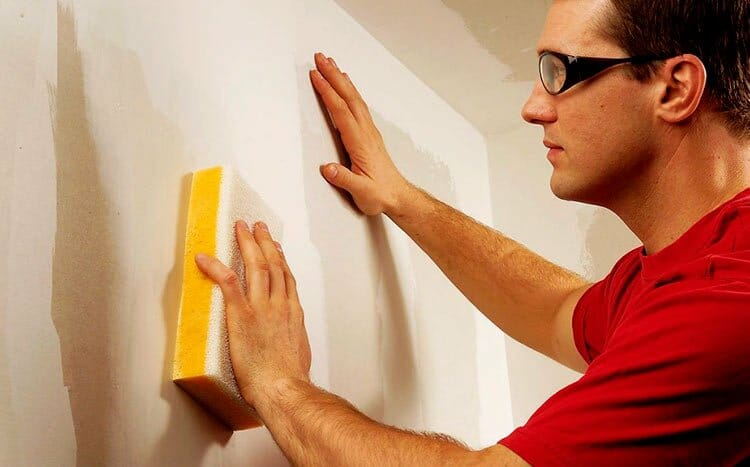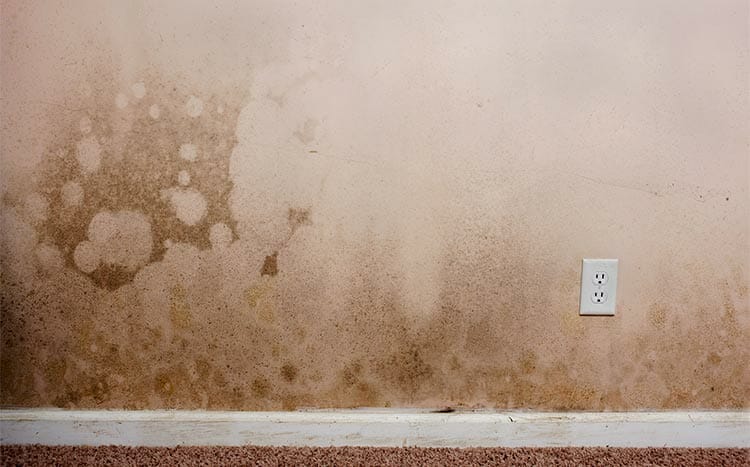Just like a sponge soaks up water, drywall can absorb moisture following events such as a flood or a burst pipe.
It is possible to save wet drywall depending on the amount of water it has been exposed to and for how long. You will need to act fast to dry out the affected drywall asap.
When the drywall is exposed to water for too long its structural integrity becomes compromised making it soft and weak, which means it will need to be replaced in most cases. That is why you should act fast or call a drywall restoration company immediately.
How to tell if drywall is wet
Once you suspect that your drywall may have been exposed to water, the first thing you should do is check for moisture. You can remove the baseboard and poke holes using a screwdriver to determine whether the drywall is soft or hard. If it is soft, this is an indication that it is wet.
You can also test for moisture content using a non-penetrating moisture meter. The moisture meter will help you determine whether there is any moisture, no matter how low the content is.

How to dry drywall after water damage?
Speed is essential to prevent water damage and save your wet drywall. Once drywall becomes wet, it becomes spongy because the porous material absorbs moisture quickly. The moisture will then spread behind the trim and baseboards and eventually saturate the insulation.
To save your drywall and prevent potential mold growth, the following 5 steps will guide you to dry your drywall fast.
Measure the extent & open it up
If the water has penetrated the drywall to the insulation, you will need to be cut along the bottom of the wall about 2 inches high and remove that section of drywall. This will need to be left open for a week to allow it to dry.
Insulation and wet walls will hold moisture for a long time, which leads to the formation of mold clusters. This means you will be forced to replace some part of the whole drywall depending on the extent of the damage. It is best to call a professional to do the job and advise you further in such instances.
Determine the paint type or wall covering
The type of paint or wall covering also determines how fast the drywall will dry. If you can easily see the wet area of your drywall, the walls may have one or two coats of semi-gloss or flat paint. Your sheetrock will, therefore, dry faster because such paint does not hold moisture.
However, if you have covered the walls using vinyl wallpaper, two layers of wallboard, or high-gloss enamel, the drying process will take longer. Also, you may need a professional to handle the task.
Rent drying equipment
If you do not own heavy-duty air-moving equipment, you can rent them from home improvement centers. Large dehumidifiers and high-volume fans will do the job efficiently. Look for a dehumidifier that can generate a temperature of about 115 degrees F with a relative humidity of up to 14%.
Seal the room
Used plastic sheeting to cover the doorways and windows in the room to make it airtight, then put on the dehumidifier. You should regularly check the machine’s collection well and check the drywall’s progress with the moisture meter. It can take up to three days on average to dry the drywall completely.
Repaint the walls
Use your moisture meter to check if the drywall is completely dry. If you are 100% certain that the affected area is dry, paint over it with a very thin oil or alcohol-based primer coat. Once the primer is dry, apply a new coat of your preferred interior drywall paint.
If the water damage is extensive, consider contacting a professional drywall restoration company. The professionals will repair the damage fast and help you uncover the root of the problem.
What happens to Drywall once it gets wet?
Once drywall becomes wet, it becomes soft and spongy. This is because the material used to design it is porous and quickly absorbs water. If you do not act fast and leave the sheetrock wet for too long, its structural integrity will be compromised.
In addition, the insulation becomes compromised and has to be removed. Wet drywall and insulation hold water for a long time. It, therefore, attracts mold spores that become a health issue if left unchecked. Mold or mildew colonies can start growing on damp sheetrock as early as 24 to 48 hours.
If you take too long to dry the drywall, the dampness will spread to adjacent walls and cause more damage.

Do you have to replace Drywall once wet?
Not necessarily. Once your drywall becomes wet, you need to determine the extent of the damage first. This will help you know whether you can save the wall or not. Usually, a moisture meter is used to check the moisture content on drywall. If the reading is more than 1% or out of the meter’s green zone, it shows the wall is compromised and will need replacement.
At this point, you need to determine how far the damage has gone and started the drying process as soon as possible. You can DIY the project or call in a professional to it for you in case of critical issues.
How long can Drywall stay wet?
Drywall can stay wet for 48 hours. After this time, mold growth will be triggered, and you will be forced to replace the whole wall or the affected parts. For this reason, act as fast as you can and dry the drywall soon after the water damage. This way, you will reduce the risk of mold growth, and you can save your sheetrock in time.
How long does it take for drywall to dry after water damage?
It can take about 12 to 48 hours for drywall to completely dry if you use a dehumidifier. With the right fans and a good dehumidifier, your drywall will dry within two days. If you are using house fans only, drywall can take up to 5 days to dry completely.
However, if the drywall is distorted, polluted by toxic substances or sewer water, you will have to replace it. This is because such contamination is permanent and may cause health issues. Always put your family and health first and take the right measures after such incidences.
Is there waterproof sheetrock?
Yes, there is waterproof sheetrock known as Greenboard or MMR, which is Mould, mildew, and moisture-resistant in full. This gypsum board is more durable, but it has the same core found on standard sheetrock. It, however, has a thicker paper coating that is protected by wax. This makes it waterproof, and it is commonly used in bathtubs and showers.
If you want waterproof drywall, consider cement boards. Cement boards, however, require moisture barriers behind them and take longer to restore. It is guaranteed to be waterproof and is ideal for the kitchen and bathroom.
Does wet drywall attract mold?
Yes, wet drywall attracts mold clusters if left wet for too long. Insulation and wet walls tend to hold water for a long time. So, mold clusters can start developing inside the wall and spread fast.
If the drywall starts to develop mold, you need to replace the whole or some part of it, depending on how far the damage has gone. Mould is a health concern and can cause respiratory issues. So, you should replace the drywall as soon as possible.
It is best to contact trained professionals to remove moldy materials because improper removal may cause the mold spores to spread throughout the house. So, if you are unsure of your capabilities, consider hiring a professional to do the job for you.
Water damage can be disastrous and stressful, be it leaking pipes or floods. While you can save wet drywall, you can have the same issue in the future if you do not find the root cause of the problem. For this reason, ensure you find out what caused the water damage and fix the issue as soon as possible.






